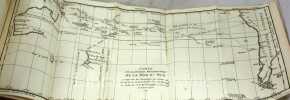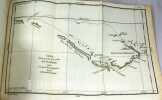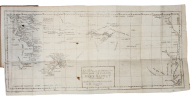4 books for « dalrymple alexander »Edit
-
Type
Book (3)
Maps (1)
-
Topics
China (1)
Maps (1)
Navy (1)
Ocean (1)
Pacific (1)
Travel (2)
-
Countries
Denmark (1)
France (3)
-
Syndicate
ILAB (3)
SLAM (2)
APRÈS de MANNEVILLETTE (Jean-Baptiste-Nicolas-Denis d') & DALRYMPLE (Alexander).
Reference : LBW-4998
(1775)
[HONG KONG] Carte d'une partie des côtes de la Chine et des isles adjacentes, depuis l'isle nommée la Pierre Blanche, jusqu'à celle de l'Artimon.
[1775-1781]. 333 x 484 mm.
Belle carte marine figurant les côtes de la Chine, et carte très importante pour la cartographie de Hong Kong. Elle a été dressée par Alexander Dalrymple d'après les observations faites à bord du senau le Goudelours et du vaisseau le Londres en 1754, 1759 et 1760. Elle s'étend à l'ouest jusqu'à Macao. Au centre, Hong Kong est identifiée sous le nom de Fanchinchow, avec les îles de Lamma, de Po Toi orthographiée Poo-Toy, et de Dangan appelée Gde Lema. La carte est traversée de lignes de rhumb permettant aux vaisseaux de maintenir leur cap. La carte est issue du Neptune Oriental, publié entre 1775 et 1781. Cet atlas, composé de grandes cartes nautiques, de cartes détaillées de parties de côtes ou d’entrées de port, était accompagné d’instructions nautiques nécessaires à la navigation entre l’Europe et l’Asie. On y trouve plus particulièrement des cartes nouvelles de Madagascar, Sumatra, Java, des Philippines et de la Chine. L’ouvrage valut une grande renommée à son auteur car il comblait les nombreuses lacunes des cartes hollandaises. Jean-baptiste d’Après de Mannevillette fut un hydrographe et capitaine de vaisseau au service de la Compagnie des Indes. En 1745, la première édition du Neptune Oriental, fruit de 12 années de travail, le rendit célèbre. Trente ans plus tard, en 1775, il publia une seconde édition, très augmentée et entièrement remaniée grâce aux informations collectées dans les journaux de bord des navires de la Compagnie des Indes et de la correspondance qu’il entretenait notamment avec l’abbé de Lacaille et l’hydrographe anglais Alexander Dalrymple. Il manque une fleur de lys ornant une ligne de rhumb, qui a été grattée à la Révolution. Très légères taches jaunes dans les parties haute et basse de la carte, avec trace de pliure dans la partie haute.
![[HONG KONG] Carte d'une partie des côtes de la Chine et des isles adjacentes, depuis l'isle nommée la Pierre Blanche, jusqu'à celle de l'Artimon.. ...](https://static.livre-rare-book.com/pictures/LBW/lbw-4998_1_thumb.jpg)
Voyages dans la mer du sud par les Espagnols et les Hollandais. Ouvrage traduit de l’Anglais par M. Dalrymple, par M. de Fréville.
Paris Saillant et Nyon ; Pissot 1774 In-8 (1) f. bl.-faux-titre, titre, (1)-xiv pp.(Avertissement)- (1) f. (Table) -502 pp.- (1) f. (Privilège) -3 cartes dépliantes, (1) f. bl., plein veau, dos à nerfs, pièce de titre de maroquin (coiffes manquantes, début de fente au mors, manque de cuir aux coins).
Première édition de la traduction française de ce traité du géographe écossais Dalrymple ((1737-1808), hydrographe de la Compagnie des Indes orientales et de l’Amirauté britannique. Libraire membre du S.L.A.M. (Syndicat national de la Librairie Ancienne et Moderne) et de la L.I.L.A. (Ligue Internationale de la Librairie Ancienne). N'hésitez pas à prendre contact par mail pour des photographies et des détails supplémentaires, pour des recherches ou des estimations de livres anciens et rares.
Voyages dans la mer du Sud, par les Espagnols et les Hollandois.
Paris,, Saillant & Nyon, Pissot, 1774. In-8 de (2)-XIV-492-[mal chiffrés 502]-(2) pp., demi-basane blonde à coins, dos lisse orné de filet doré, pièce de titre en maroquin blond, tranches jaunes (reliure de l'époque).
Première édition française, traduite par Anne-François-Joachim de Fréville, illustrée de 3 grandes cartes dépliantes : Partie Méridionale de la mer du sud, Partie de la carte depuis le cap de Bonne Espérance jusqu'à la Nouvelle Bretagne Nouvelle-Zélande, Carte de la Terre des Papous, de la Nouvelle-Guinée et des Iles de Salomon, Nouvelle-Bretagne.C'est une version abrégée de la collection de récits de voyages dans le sud de l'Océan Pacifique publiée en anglais entre 1769 et 1771. Alexender Dalrymple (1737-1808) entra très tôt dans la Compagnie des Indes orientales et réalisa pour celle-ci diverses expéditions dans l'archipel oriental des Indes, notamment en Indonésie. Il devint par la suite hydrographe royal. Ses nombreuses observations permirent le succès du premier voyage de Cook.Brunet II, 474 ; Chadenat, 3184 «Ouvrage important pour l'histoire des découvertes aux terres australes ».
FRÉVILLE, ANNE FRANÇOIS JOACHIM DE (+) [ALEXANDER DALRYMPLE].
Reference : 57765
(1776)
Berättelse om de nya uptäckter, som blifwit gjorde i Söderhafwet, åren 1767, 1768, 1769 och 1770, författad, enligt sednaste underrättelser, af hr. De Freville, med en bifogad charta af hr. Vaugondy. Ofwersatt ifrån fransyska. 2 vols.
Upsala, Johan Edman, 1776. 8vo. 2 volumes bound in one contemporary half calf binding with five raised bands and gilt lettering to spine. Ex-libris pasted on to pasted down front end-paper. Occassional brownspotting throughout. (28), 308, (2)" (2), 326, (6]) pp. + folded map.
Swedish translation of Fréville's 'Hhistorie des Nouvelles Découvertes...', first published in Paris in 1774, being an abdriged version of Alexander Dalrymple's 'Voyages and Discoveries in the South Pacific Ocean"". Regarding the map Kroepelien notes: ""it was issued sometime after the publication of both volumes and is thus frequently missing.""Kroepelien 471Beddie 721Hill 411Sabin 25913 (1774-edition)
 Write to the booksellers
Write to the booksellers![[HONG KONG] Carte d'une partie des côtes de la Chine et des isles adjacentes, depuis l'isle nommée la Pierre Blanche, jusqu'à celle de l'Artimon.. ...](https://static.livre-rare-book.com/pictures/LBW/lbw-4998_1.jpg)











